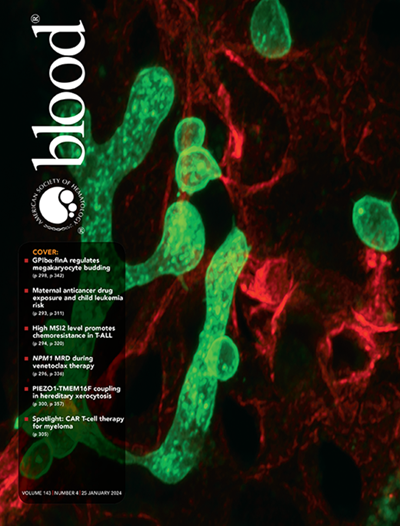Intestinal hepcidin overexpression promotes iron deficiency anemia and counteracts iron overload via DMT1 downregulation.
IF 23.1
1区 医学
Q1 HEMATOLOGY
引用次数: 0
Abstract
Hepcidin is the key hyposideremic hormone produced primarily by the liver. However, recent reports reveal extra-hepatic functional sources of hepcidin, including the intestine, the site of dietary iron absorption. To determine whether intestinal hepcidin may play a role in plasma iron lowering, we generated transgenic mice overexpressing the peptide specifically in this tissue. At one month of age, transgenic mice exhibited severe iron deficiency along with decreased haematological indices and a drastic suppression of liver hepcidin in response to hyposideremia. Mechanistically, we showed that intestinal hepcidin was produced in the intestine lumen, inducing a striking down-regulation of Divalent Metal Transporter 1 (DMT1) protein at the enterocyte. To confirm the capacity of hepcidin to decrease DMT1, we developed food-grade recombinant lactic acid bacteria (recLAB) genetically modified to deliver hepcidin directly into the intestinal lumen. These recLAB induced a rapid decrease of duodenal DMT1 and, most importantly, when daily orally administrated, protected against iron overload in a mouse model of hemochromatosis. Taken together, our data reveal a previously unrecognized role of intestinal hepcidin as a regulator of systemic iron homeostasis, acting on DMT1 on the apical side of enterocytes, with potential therapeutics relevance for haematological or iron disorders.肠道hepcidin过表达可促进缺铁性贫血,并通过下调DMT1来抵消铁超载。
Hepcidin是主要由肝脏产生的一种关键的低铁血症激素。然而,最近的报道揭示了hepcidin的肝外功能来源,包括肠道,膳食铁的吸收部位。为了确定肠道hepcidin是否可能在血浆铁降低中发挥作用,我们在该组织中产生了特异性过表达该肽的转基因小鼠。在1月龄时,转基因小鼠表现出严重的缺铁,血液指标下降,低铁血症导致肝脏hepcidin急剧抑制。在机制上,我们发现肠hepcidin在肠腔中产生,诱导肠细胞中二价金属转运蛋白1 (DMT1)蛋白的显著下调。为了证实hepcidin降低DMT1的能力,我们开发了转基因食品级重组乳酸菌(recLAB),将hepcidin直接输送到肠腔。这些recLAB诱导十二指肠DMT1的快速减少,最重要的是,在血色素沉着症小鼠模型中,每天口服时,可以防止铁过载。综上所述,我们的数据揭示了肠道hepcidin作为全身性铁稳态调节剂的作用,其作用于肠细胞顶端的DMT1,与血液学或铁疾病的潜在治疗相关。
本文章由计算机程序翻译,如有差异,请以英文原文为准。
求助全文
约1分钟内获得全文
求助全文
来源期刊

Blood
医学-血液学
CiteScore
23.60
自引率
3.90%
发文量
955
审稿时长
1 months
期刊介绍:
Blood, the official journal of the American Society of Hematology, published online and in print, provides an international forum for the publication of original articles describing basic laboratory, translational, and clinical investigations in hematology. Primary research articles will be published under the following scientific categories: Clinical Trials and Observations; Gene Therapy; Hematopoiesis and Stem Cells; Immunobiology and Immunotherapy scope; Myeloid Neoplasia; Lymphoid Neoplasia; Phagocytes, Granulocytes and Myelopoiesis; Platelets and Thrombopoiesis; Red Cells, Iron and Erythropoiesis; Thrombosis and Hemostasis; Transfusion Medicine; Transplantation; and Vascular Biology. Papers can be listed under more than one category as appropriate.
 求助内容:
求助内容: 应助结果提醒方式:
应助结果提醒方式:


